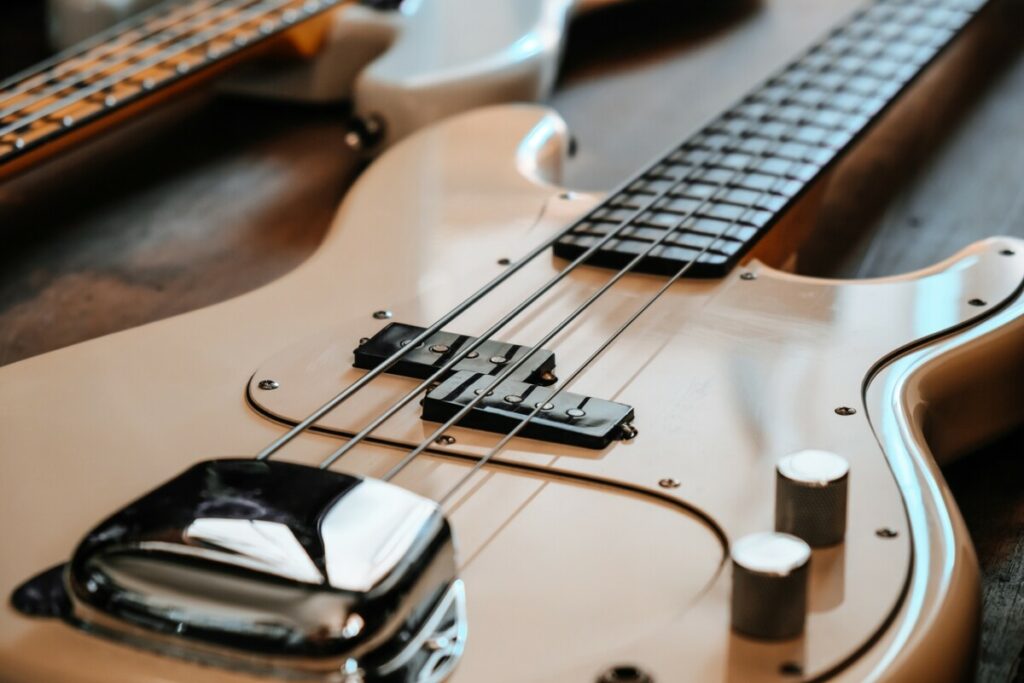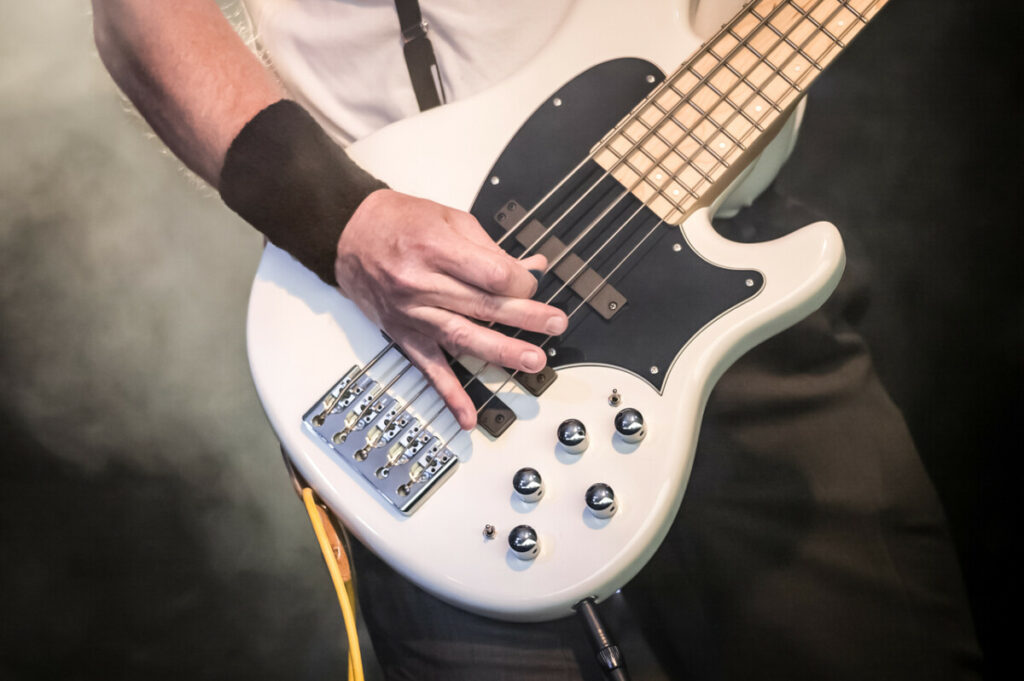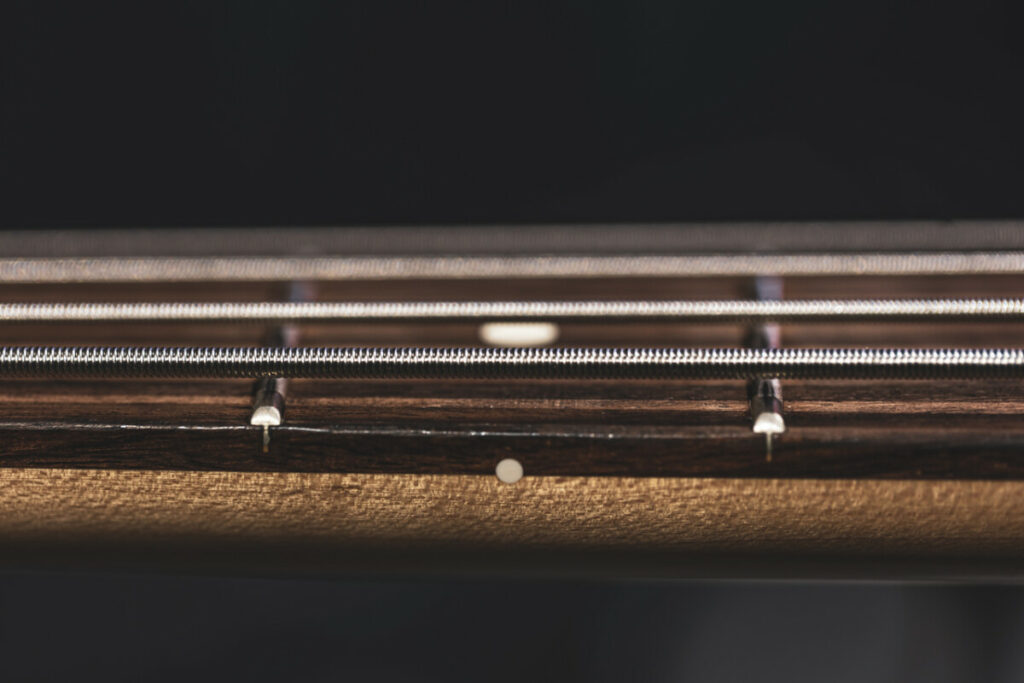Let’s dive into the world of bass guitars, shall we? As an aspiring bassist, you’re about to explore each integral component that comes together to produce that distinct and resonating sound. So buckle up!
We’ll be breaking down the headstock, fretboard, neck, pickups, bridge, and strings – all vital pieces in creating your future music.
Table of Contents
Headstock

When you take a gander at a bass guitar, the headstock is that distinctive piece you’ll spot right at the top. It’s definitely a conversation starter with its unique design elements – from traditional vibes to edgy modern aesthetics.
Most of your headstocks are crafted from either wood or metal, sometimes even both! And it usually rocks the same color as the rest of your instrument for that smooth and seamless look.
Tuning pegs? They’re on there too. They let you play around with pitch until each string sounds just perfect. Not forgetting about our trusty nut which ensures those strings stay exactly where they should be.
Then we’ve got branding – an impressive logo emblazoned smack in the middle of it all, representing who made this sweet beast!
But hey, don’t stop there! Why not make this yours by adding some personal touches? Stick some pickguards on there or maybe truss rod covers; really anything to amp up and personalize its whole vibe.
To sum up – The bass guitar’s headstock isn’t just another part. It’s like an artist’s signature on their masterpiece setting off a ripple effect for how rad everything else looks and feels.
Fretboard

Your bass guitar’s fretboard is the stage where your strings dance to create those killer notes. It’s an absolute core of your instrument and it demands care, attention, and a bit of personal touch to ensure it performs its best.
Keeping that fretboard spick-and-span isn’t just good housekeeping; it prevents potential damage too. Grab a gentle cloth or even invest in some dedicated fretboard cleanser – you’ll keep that thing gleaming from day one.
Why not jazz up your fretboard while you’re at it? Adding custom graphics or switching out the wood type can make your bass uniquely yours, adding character and style along with functionality.
So remember: give that fretboard the TLC (tender loving care) it deserves through regular maintenance and customization. This way, you’ll keep both its visuals appealing and sound quality top-notch.
Neck
The bass guitar’s neck, the bridge between the body and headstock, is a crucial part of your instrument that needs consistent care and attention. Here are some vital deets to remember about your bass guitar’s neck:
- The size of your strings will have an impact on how your neck is shaped.
- Fret widths can fluctuate based on different styles of the neck.
- The way the neck was built plays a huge role in determining how it feels when you play.
- It’s important that you find a profile for the neck that suits you best and offers comfort while playing.
When deciding which bass to purchase, never overlook or underestimate just how essential this portion of our favorite four-stringed friend truly is. If it doesn’t feel right or isn’t sized properly, jamming out could turn into an uphill battle.
In summary: don’t sleep on considering all things related to a potential new bass’s neckline – its relevance cannot be overstated when selecting your ideal axe!
Pickups

Electric bass guitars rely heavily on pickups to transmit their sound through an amplifier. These vital components are available in various styles, can be strategically placed at multiple points on the bass, and wired distinctively for different effects.
Any self-respecting bassist needs a good grasp of how these pickups work.
Types of Pickups
The type of pickup you use can drastically change your guitar’s sound profile. From single-coil pickups that cut sharply through the mix to the best humbucker pickups that deliver rich full tones – there is a perfect fit for everyone’s taste. Let’s get into some of the fan favorites:
Single-coil: Constructed from one coil of wire and typically made with materials like ceramic, steel, or aluminum – these guys offer up crisp bright tones.
Humbuckers: Crafted with two coils of wire; they’re known for delivering warmer sounds packed with depth and richness.
Piezo Pickups: Made using piezoelectric crystals; often chosen when you’re after softer mellower tonalities.
Active Pickups: The rockstars among all types! Powered by an external source, offering unparalleled control over tone variations- creating unique sounds has never been easier!
Pickup Placement
Listen up, where you put your pickups is a total game-changer for how your instrument will sound. Depending on where they’re placed, the variety of tones and sounds you can get are pretty wild. But like everything else in life, every placement has its pros and cons.
Placing pickups near the bridge? That’ll give you a crisper tone with some serious output– perfect if you’re going for that crystal-clear sound. Just be careful though; it’s easy to tip over into sounding too harsh or distorted territory.
If mellow vibes are more your style, try placing them further from the bridge. You’ll end up with a warmer and softer sound- super chill right? The downside here is that things might start getting blurry in terms of clarity – no one likes their music sounding like mud soup!
The middle ground’s not bad either when we talk about pickup placements – bang in between bright and warm tones! It’s kind of having an all-access pass: great range but at times things could get too muted leading to loss of definition.
At the end of the day though—it all depends on what kind of tunes want outta ya instrument! Weighing out those pros against those pesky cons before making any decisions seems smart—just don’t rush it okay?
Pickup Wiring
You might be thinking about wiring your bass guitar pickups. Depending on the type of active pickups you’ve chosen, there’s more than one way to get them wired up right. The most popular kind is hum canceling – it keeps any annoying buzz from ruining your sound.
Here are some alternatives for getting those pick-ups connected:
- Decide if you’re going with single-coil or humbucker pickups.
- Hook up your pickups directly to a pickup switch.
- Link the pickups to either volume or tone control knobs (pots).
- Mix things up by connecting your pick-ups both to a selection switch and volume/tone pots.
Regardless of which route you take, ensure all connections are tight and secure. Incorrect wiring can mess with the quality of sound output so double-check everything before jamming out!
The perfect combination of setup and proper wiring will give life to an awesome-sounding bass guitar that totally rocks!
Bridge
You’ve got to know your bass guitar’s bridge inside out. It’s the crucial part which not only provides the adjustment for setting string height and intonation, but also holds the strings in tune as you play.
There are several different types of bridges and methods of bridge tuning – it’s time to get to know them!
Types of Bridges
Different kinds of bridges can be found on a bass guitar, like the string-through, top-loading, or tailpiece models. Each one uses various materials to produce the perfect sound for your bass guitar. Here are some widely used bridge types:
- String-through: In this setup, the strings thread through the body of the bass itself with their ends secured by the bridge. This gives an added boost to sustain while also producing brighter tones.
- Top-loading: The unique feature here is how strings attach directly onto the top part of this type of bridge which then mounts onto your instrument’s body. If you love experimenting with sounds or desire greater expression from each stroke – go for it!
- Tailpiece: Mounted at rear side on a guitar’s frame/body where all its strings get attached too; provides smoother tunes with mellow vibes.
- Adjustable: As implied in its name; these have adjustable features enabling tension alterations along different points across individual strings allowing further scope for musical exploration and creating distinctive melodies.
Bridge Tuning
Tweaking your bridge’s tension can seriously upgrade the audio output of your instrument. This critical fine-tuning process is key to keeping your bass guitar pitch-perfect and sounding top-notch.
When you’re dialing in the perfect sound for the bridge, you’ve got to focus on two main elements: string height and intonation. You manage string height by cranking up or down on those bridge saddles, positioning them just right so that they’re at an ideal distance from the fretboard.
Intonation? That’s all about nudging that saddle forward or backward. Doing this makes sure each of your strings is perfectly harmonizing with one another – because who wants a discordant bass?
While making these tweaks, it’s crucial to keep checking in regularly with how well everything is tuned – ensuring every alteration you make keeps things properly aligned.
With some patience and precision tuning work on your end, there won’t be any genre of music out of reach for you – whether it’s jazz fusion jamming sessions or dropping bombshell grooves in a heavy metal band! Your finely tuned bass will be ready to roar!
Strings
Bass guitar strings are the life and soul of your instrument; they’re responsible for that unique vibe you get when strumming out those deep, resonant sounds. To really hit the sweet spot with your sound, consider these factors when choosing new strings:
- Gauge: The thickness – or gauge – of your strings dramatically influences how they resonate. Beefy, heavier ones will dish up a richly deep tone while lighter gauges pack more punch with their brighter tones.
- Material: String composition isn’t one-size-fits-all! Steel is typically the go-to choice but don’t overlook nylon or coated options – each has its distinct sonic signature.
- Action: Tweak this to change not only how easy it is to play but also the control over notes you have. If smooth sailing’s what you’re after, lower action’s where it’s at. Craving more manipulation? Heighten that action!
- Tension: How tight or loose your bass guitar strings sit can sway their tonal quality massively too. Tighter equals brightness whereas looser gives off a relaxed mellow feel.
Frequently Asked Questions
What Is the Best Type of Wood for a Bass Guitar?
When it comes to rocking out on a bass guitar, your choice of wood plays an essential role in defining tone quality and string gauge. While alder and mahogany lend themselves to mellower tones, maple gives you that crisp resonance. Choose according to your unique vibe.
How Do I Properly Tune My Bass Guitar?
Getting your bass guitar perfectly tuned is all about nailing the right sound. It involves tweaking amplifier settings and fine-tuning string tension with precision. With enough practice, hitting that perfect pitch will become second nature.
How Often Should I Restring My Bass Guitar?
The frequency at which you restring depends on factors like string material and gauge – but typically every few months does the trick or more frequently if you’re jamming daily. Remember, picking suitable strings for your instrument is key!
What Is the Difference Between Passive and Active Pickups?
You might find yourself pondering over passive versus active pickups while strumming away — here’s what separates them; passive kinds operate using magnets whereas actives run off battery-powered preamps giving higher output! Also, remember fretboard materials & neck shape are variable too depending upon the pickup type chosen- so go ahead and dive deep into this musical expedition!
What Is the Best Way to Care for My Bass Guitar?
To keep up with regular wear-and-tear of playing gigs or just practicing alone in your room make sure cleaning & maintenance aren’t overlooked! Wipe down regularly using a soft dry cloth inspect carefully and replace worn parts as needed Maintain it as per manufacturer’s recommendations use the right products when repairing minor damages Here’s hoping many years filled with great tunes await!
Conclusion
Alright, so you’ve made it through the crash course on bass guitars. You’re now armed with the basics:
- the headstock
- fretboard
- neck
- pickups
- bridge
- strings
Every element is vital in crafting your unique sonic signature; hence understanding these parts becomes crucial.
Now with this wisdom under your belt, you are all set to shape up some phenomenal pieces of music—something truly reflective of who you are as an artist.

